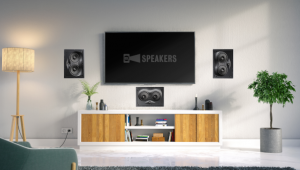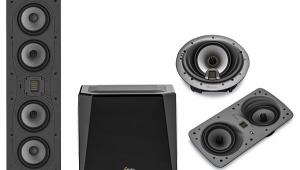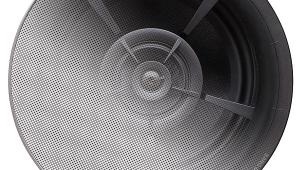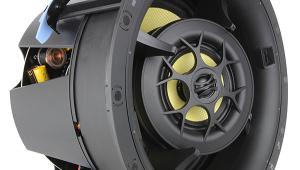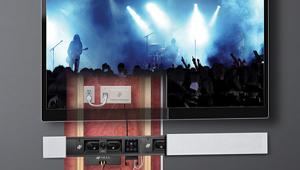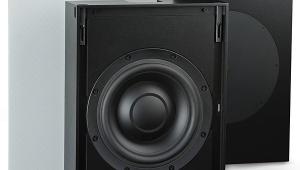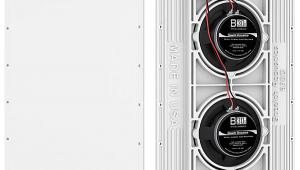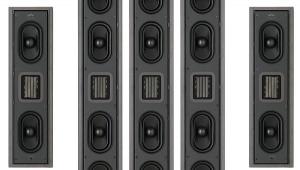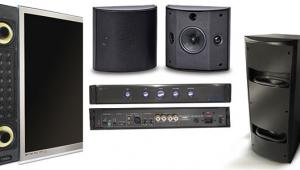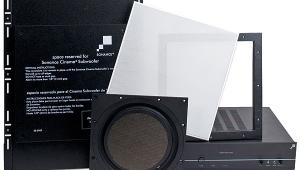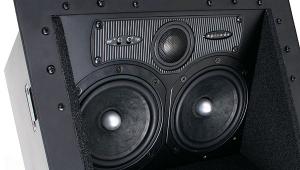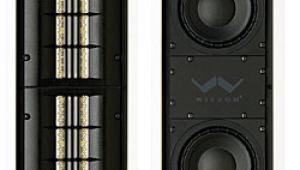Polk Audio LC265i-IP In-Wall Speaker
It seems that all new consumer electronics products are either digital, Web-based, or both. One of the last holdouts are loudspeakers, which still operate mainly in the analog domain with no Web-based functions. Polk Audio has broken from that mold with the LC265i-IP in-wall loudspeaker. The LC265i-IP is the first active in-wall speaker for home audio powered by digital amplifiers that you can control via an Internet Protocol (IP)–based system. The full package, including the speakers, resides on a local area network, similar to the way a PC resides on a larger network connected to the Internet. The IP control assigns a unique number, or address, to each component in the system. The speakers in my test sample were connected to a NetStreams DigiLinX audio distribution system, which distributes digital audio throughout a networked home. Although I used the DigiLinX system for the purpose of this review, Polk Audio designed the LC265i-IP speakers to be compatible with a variety of IP-capable audio distribution systems, which are certainly a growing trend in wholehouse audio and video systems.
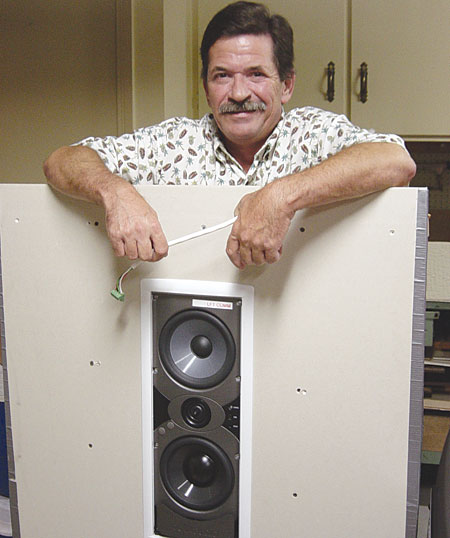
The list of IP-addressable or IP-controllable products for the home is growing rapidly, largely because of the number of networked homes, sometimes referred to as "smart homes." A networked home is wired throughout with Ethernet cable that forms a network of computers, audio/video components, or other appliances. IP-controllable products include things like televisions, lighting systems, landscape-irrigation systems, swimming-pool controls, and security systems—even refrigerators. You can control and operate these devices with an Internet-enabled device, such as a PC, a PDA, a wireless tablet, or a keypad designed specifically for this purpose. Each of the components on the network has its own unique IP address. Technically, the correct term is TCP/IP, defined as Transmission Control Protocol/Internet Protocol, the universal language of the Web.
Advantages of IP-Addressable Speakers and Audio Systems
There are real advantages to IP-addressable and IP-controllable audio distribution systems, such as NetStreams and the Polk Audio IP-addressable speaker. First and foremost is audio quality—the audio signal is at a 96-kilohertz sampling frequency, with 24-bit digital audio in the form of uncompressed WAV files distributed over a network of Cat-5 (or Cat-5e, Cat-6) Ethernet cables. The system converts the signal to analog only when it reaches the digital-to-analog converter and the amplifier on the back of each speaker, so audio quality is maintained over long distances.
A typical multiroom distribution system uses runs of speaker wire to send analog audio signals from a central amplifier to each speaker, which can degrade the signal over long distances. Second, and equally important, is the fact that a multiroom system typically requires many hours of setup and programming with a PC, which adds to the complexity and cost of the installation. Programming a multiroom system is not a DIY project for most people. Any change to the system, such as adding a new component, means a service call and more programming.
An IP-addressable system, such as the NetStreams DigiLinX, automatically recognizes new components introduced to the system by assigning each one a unique IP address, which eliminates the need for programming. I can verify the advantage of automatic recognition, as I have spent many hours late into the evening waiting for a programmer to complete the setup of complex multiroom systems for trade-show demonstrations and other events.
Performance Optimization Wizard (POW)
A unique feature of the LC265i-IP speakers is Polk's proprietary Performance Optimization Wizard (POW) software. POW is a PC-based DSP software tool that optimizes the speakers' sound quality based on placement, room acoustics, and other important factors that affect a loudspeaker's performance. The LC265i-IP speakers come with the POW software on a CD-ROM, and setup is a DIY procedure, although most people will probably prefer to let their installer do the work. But, if you're a computer geek, go for it!
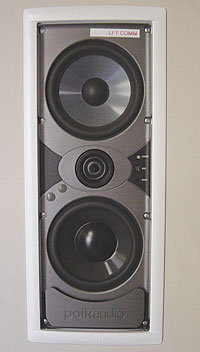 In-wall loudspeakers face more difficult challenges than freestanding speakers, mostly because people use them in unpredictable installations, and their sound quality depends upon wall construction, placement, and other factors. Residential walls vary significantly in construction materials, wall-cavity volume, and rigidity, and all of these factors dramatically affect an in-wall speaker's sound.
In-wall loudspeakers face more difficult challenges than freestanding speakers, mostly because people use them in unpredictable installations, and their sound quality depends upon wall construction, placement, and other factors. Residential walls vary significantly in construction materials, wall-cavity volume, and rigidity, and all of these factors dramatically affect an in-wall speaker's sound.
The Polk POW system takes into consideration room acoustics, speaker placement, and other installation parameters, and it works well. I put the Polk speakers and the POW software to the test by moving the entire system into my garage, which is hardly a fine-tuned listening room. I reasoned that, if the POW system could make the system sound good in my garage, the living room would be a cinch. (Check out the picture on the following page. You wouldn't want all of this gear in your living room, either. This equipment would be concealed in a professional installation.)
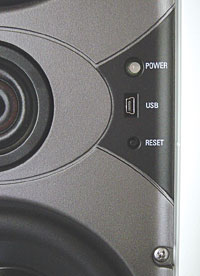 The Polk Audio POW software asks the user to define several basic parameters of the room acoustics and the installation. (See the sidebar on the following page.) All you'll need for this is a tape measure and a basic knowledge of room acoustics. When complete, the software updates a DSP module in the speaker with the new system parameters, and the sound changes according to the characteristics entered. The software works well, even if the speakers are set up in less-than-ideal positions (for example, nonsymmetrical placement within a room). The POW system did a good job of compensating for these real-world installation challenges and even kept the sound image focused in the center when the left speaker was 15 feet farther from my listening position than the right speaker. My garage has a somewhat lively acoustic quality, since there are no furnishings, carpet, or drapes to dampen the sound, but the POW software easily compensated for some of this.
The Polk Audio POW software asks the user to define several basic parameters of the room acoustics and the installation. (See the sidebar on the following page.) All you'll need for this is a tape measure and a basic knowledge of room acoustics. When complete, the software updates a DSP module in the speaker with the new system parameters, and the sound changes according to the characteristics entered. The software works well, even if the speakers are set up in less-than-ideal positions (for example, nonsymmetrical placement within a room). The POW system did a good job of compensating for these real-world installation challenges and even kept the sound image focused in the center when the left speaker was 15 feet farther from my listening position than the right speaker. My garage has a somewhat lively acoustic quality, since there are no furnishings, carpet, or drapes to dampen the sound, but the POW software easily compensated for some of this.
The POW system performed equally well in my living room. Although the acoustic conditions are far better than those in my garage, the software did a good job of accounting for typical installation situations, such as placement close to a corner, which is sometimes unavoidable and can create boomy bass response.
Sound Quality
Almost two years ago, I reviewed the Polk Audio LC-265i speakers and enjoyed their sound quality. They are the same model without the digital amplifiers, the DSP module, and the NetStreams network card. I noted in that review that the LC-265i speakers had a pleasantly balanced tonal quality and were easy to listen to for long periods. Also for that review, I used the optional Polk Audio Performance Enclosures, but, this time, I mounted the speakers in temporary walls without the benefit of the specially designed enclosures. Even without the Performance Enclosures, I thought that the IP model sounded better, with fuller, tighter, more controlled bass response, even without a subwoofer. In fact, I used the same demo material to evaluate the Polk IP model, and I heard improved results with each demo. Bela Fleck's Drive, a two-channel recording (SACD, Mobile Fidelity), revealed nicely detailed midrange and high-frequency characteristics with excellent transient response. The live album Alison Krauss + Union Station (SACD, Rounder Records) sounded excellent through the Polk Audio LC265i-IP speakers.
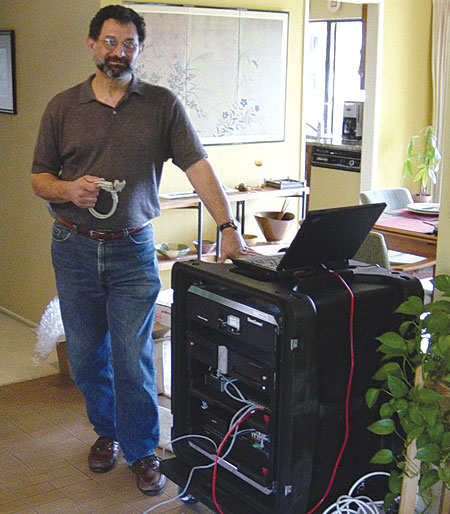
The LC265i-IP is a two-and-a-half-way speaker with one 6.5-inch woofer, one 6.5-inch midwoofer, and a 1-inch ring radiator mounted on a pivot that you can angle up to 15 degrees. It is a triamplified speaker with 100 watts for the bass driver, 75 watts for the midwoofer, and 25 watts for the tweeter. The amplifier and DSP modules, which attach to the back of each speaker, require a 48-volt DC power input from a Polk SPS-1 remote power supply. An optional NetStreams SN1000 StreamNet IP Card is available for an IP-controllable system. If you choose to connect the speakers to a non-networked analog audio system, connect the left- and right-channel shielded RCA cables to the amplifier inputs. The good news is that you can still use the POW software with an analog system via a PC connected to the USB port on the speaker's front baffle. So, even if you don't have a networked wholehouse audio distribution system, you can still benefit from one of the most unique features, the company's POW software, and upgrade later to IP control if you desire.
Summary
The Polk Audio LC265i-IP speakers are a significant step forward for in-wall loudspeakers. The built-in digital power amplifiers sound good and eliminate long runs of analog speaker wire. The DSP function with the POW software allows for fine-tuning of the speakers' tonal characteristics, and IP controllability is way ahead of the curve. If you prefer a round, ceiling-mounted speaker, Polk's LC80i-IP has similar features. If you have a networked home, put it to good use with an IP-based audio distribution system and a pair of LC265i-IP speakers. Even if you're living in the analog domain, you'll still enjoy the sound of these speakers.
Highlights
• The first IP-addressable in-wall speaker
• Built-in digital signal processor and room-compensation software
• Uses same driver technology as Polk's LSi Series
